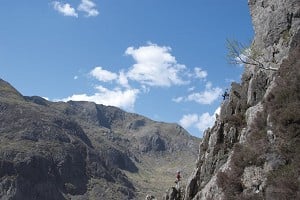
The following article is based on text from the book Trad CLIMBING + published by Rockfax. This article version was written by Adrian Berry and Alan James, and the illustrations are by Ray Eckermann.
When you fall off a route the piece of equipment that contributes the most to absorbing the energy of the fall is the rope. In general, the more rope freely available to stretch during the fall, the safer the fall will be and this can be measured by using a ratio known as the fall factor.
The fall factor is simply the distance fallen, divided by the amount of rope available to absorb that fall. The principle is that, the lower the fall factor, the safer the fall. The distance fallen isn't important on its own and in some situations longer falls are safer than shorter ones, which is contrary to what most people might expect. The important thing is how much force is transmitted to the top piece of protection and this is where the fall factor comes into play - a large fall factor (which can be a very short fall if low on a pitch) transmits a large force, and a small fall factor (which can be a huge 'winger' if high on a pitch) transmits a smaller force.
The illustrations below show several different situations and the fall factors you might experience.

Here, a climber has taken a 2m fall with 10m of rope out giving a fall factor of 0.2 (2/10) - a very soft fall.
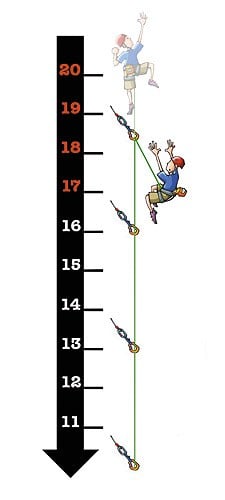
If the climber had been twice as high on the route (20m), and taken a longer fall of 3m, the fall factor would be only 0.15 - significantly less - and safer - even though it might have been a bit more scary!
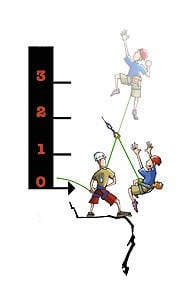
In this example, the climber has once again fallen 3m, but had only just moved above the belay, and so only had 3m of rope out - giving a high fall factor of 1.0.
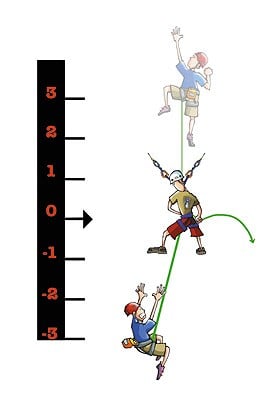
Here, our friend has fallen 6m, with only 3m of rope to absorb the fall, producing a very large fall factor of 2.0. If the belayer had quickly reacted and taken in some slack (an intuitive reaction) while his friend was whistling past (an armful is about 0.5m), the fall factor would have increased to a very worrying 2.4.

Real world fall factors
The fall factor is a very useful way of understanding just how the forces of a fall are dissipated and the role of the rope in not just stopping a fallen climber but stopping them gradually.
The examples above are highly simplified and in each example the rope is running perfectly free. In practice, each time the rope runs against either a karabiner or the rock, it reduces its ability to absorb force through its full length.
In the example on the right, the presence of only four twenty degree bends in the rope caused by runners is enough to more than double the fall factor from 0.3 to 0.6 due to the added friction in the system.
A more severe point of friction, such as a ledge where protection has been placed at the back, or the lip of an overhang, where protection has not been sufficiently extended, can as much as double the force on the top piece of protection - taking it into the realm of failure.
So are long falls safe?
Far from it, since there are many other crucial factors you need to consider. The further you fall, the more likely you are to hit something - this could be the ground, of course, but it could also be a ledge, or a protruding section of rock. In addition, the effects of a swing are increased if you fall further.
The main point to learn from fall factors is that a fall from low on a pitch often transmits more force to a runner than one from high on a pitch, even if you only fall a short distance. When you fall past a belay, the fall factor can become critical. The way to counter this is make sure your early runners are good ones, and place a few when leaving stances on multi-pitch routes.
Sponsored Link
Trad CLIMBING + from ROCKFAX
Trad Climbing+ is a climbing text book that focuses on modern traditional climbing from a British perspective.
"The best how to book on trad climbing to date. I only wish it was around when I started climbing."
The aim of Trad Climbing+ is to offer a balance of safety-focussed ropework and protection skills with equally useful tactical and psychological ideas that drive the individual to succeed. Trad Climbing+ is the first book of its kind ever to include in-depth coverage of coaching-derived ideas that will allow the reader to reach new levels of confidence and ability without embarking on lengthy training programmes. There's a sample chapter here.



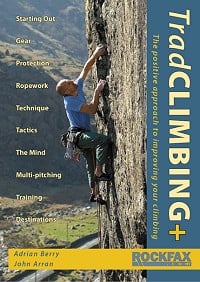

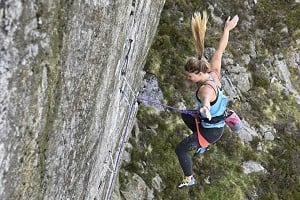











Comments